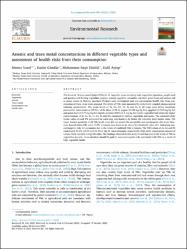| dc.contributor.author | Varol, Memet | |
| dc.contributor.author | Gündüz, Kazım | |
| dc.contributor.author | Sünbül, Muhammet Raşit | |
| dc.contributor.author | Aytop, Halil | |
| dc.date.accessioned | 2022-03-16T20:23:05Z | |
| dc.date.available | 2022-03-16T20:23:05Z | |
| dc.date.issued | 2022 | en_US |
| dc.identifier.citation | Varol, M., Gündüz, K., Sünbül, M. R., & Aytop, H. (2022). Arsenic and trace metal concentrations in different vegetable types and assessment of health risks from their consumption. Environmental Research, 206, 112252. | en_US |
| dc.identifier.issn | 0013-9351 | en_US |
| dc.identifier.uri | https://doi.org/10.1016/j.envres.2021.112252 | |
| dc.identifier.uri | https://hdl.handle.net/20.500.12899/660 | |
| dc.description.abstract | The levels of 12 trace metal (loid)s (TMs) in 10 vegetable types including leafy vegetables (purslane, purple basil and parsley) and fruiting vegetables (pepper, tomato, eggplant, cucumber, zucchini, green bean and melon) and in maize grown in Malatya province (Turkey) were investigated and non-carcinogenic health risks from consumption of these crops were assessed. The levels of TMs were measured by inductively coupled plasma-optical emission spectrometry. The mean levels of Ni, Cu, Cd, Cr, As and Zn in all crops were below maximum permissible concentrations (MPCs), while those of Pb in pepper (0.109 mg/kg fw), eggplant (0.103 mg/kg fw) and green bean (0.177 mg/kg fw) slightly exceeded MPCs (0.1 mg/kg fw). Leafy vegetables had relatively higher concentrations of Al, As, Ba, Cr, Cu, Fe and Mn compared to fruiting vegetables and maize. The estimated daily intake value of each TM estimated for each crop was found to be below the tolerable daily intake value. The target hazard quotients of all TMs in all crops did not exceed the acceptable non-carcinogenic risk level. However, hazard index (HI) value (1.57) in tomato was found to be above the threshold value of 1, indicating non-carcinogenic risks for consumers due to the intake of combined TMs in tomato. The THQ values of As, Co and Pb contributed 46.4%, 24.5% and 16.4% of the HI value of tomato, respectively. High daily consumption amount of tomato likely resulted in high HI value. The findings obtained in this study reveal that even if the levels of TMs in vegetables are safe, more attention should be paid to non-carcinogenic risks associated with TMs as a result of high vegetable intake. | en_US |
| dc.language.iso | en | en_US |
| dc.publisher | Elsevier | en_US |
| dc.relation.ispartof | Environmental Research | en_US |
| dc.rights | info:eu-repo/semantics/closedAccess | en_US |
| dc.subject | Arsenic | en_US |
| dc.subject | Consumption rate | en_US |
| dc.subject | Health risks | en_US |
| dc.subject | Trace metals | en_US |
| dc.subject | Vegetables | en_US |
| dc.title | Arsenic and trace metal concentrations in different vegetable types and assessment of health risks from their consumption | en_US |
| dc.type | Article | en_US |
| dc.authorid | 0000-0001-6475-0570 | en_US |
| dc.department | MTÖ Üniversitesi, Doğanşehir Vahap Küçük Meslek Yüksekokulu, Su Ürünleri Bölümü | en_US |
| dc.institutionauthor | Varol, Memet | |
| dc.institutionauthor | Gündüz, Kazım | |
| dc.identifier.doi | 10.1016/j.envres.2021.112252 | |
| dc.identifier.volume | 206 | en_US |
| dc.relation.publicationcategory | Makale - Uluslararası Hakemli Dergi - Kurum Öğretim Elemanı | en_US |
| dc.identifier.pmid | 34687751 | |
| dc.identifier.scopus | 2-s2.0-85117730565 | en_US |
| dc.identifier.scopusquality | Q1 | en_US |
| dc.identifier.wos | WOS:000766429300002 | en_US |
| dc.identifier.wosquality | Q1 | en_US |
| dc.indekslendigikaynak | Web of Science | en_US |
| dc.indekslendigikaynak | Scopus | en_US |
| dc.indekslendigikaynak | PubMed | en_US |


















